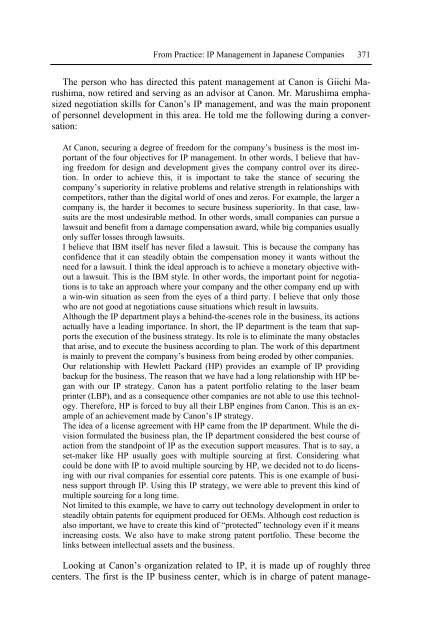Management of Technology and Innovation in Japan
Management of Technology and Innovation in Japan
Management of Technology and Innovation in Japan
Create successful ePaper yourself
Turn your PDF publications into a flip-book with our unique Google optimized e-Paper software.
From Practice: IP <strong>Management</strong> <strong>in</strong> <strong>Japan</strong>ese Companies 371<br />
The person who has directed this patent management at Canon is Giichi Marushima,<br />
now retired <strong>and</strong> serv<strong>in</strong>g as an advisor at Canon. Mr. Marushima emphasized<br />
negotiation skills for Canon’s IP management, <strong>and</strong> was the ma<strong>in</strong> proponent<br />
<strong>of</strong> personnel development <strong>in</strong> this area. He told me the follow<strong>in</strong>g dur<strong>in</strong>g a conversation:<br />
At Canon, secur<strong>in</strong>g a degree <strong>of</strong> freedom for the company’s bus<strong>in</strong>ess is the most important<br />
<strong>of</strong> the four objectives for IP management. In other words, I believe that hav<strong>in</strong>g<br />
freedom for design <strong>and</strong> development gives the company control over its direction.<br />
In order to achieve this, it is important to take the stance <strong>of</strong> secur<strong>in</strong>g the<br />
company’s superiority <strong>in</strong> relative problems <strong>and</strong> relative strength <strong>in</strong> relationships with<br />
competitors, rather than the digital world <strong>of</strong> ones <strong>and</strong> zeros. For example, the larger a<br />
company is, the harder it becomes to secure bus<strong>in</strong>ess superiority. In that case, lawsuits<br />
are the most undesirable method. In other words, small companies can pursue a<br />
lawsuit <strong>and</strong> benefit from a damage compensation award, while big companies usually<br />
only suffer losses through lawsuits.<br />
I believe that IBM itself has never filed a lawsuit. This is because the company has<br />
confidence that it can steadily obta<strong>in</strong> the compensation money it wants without the<br />
need for a lawsuit. I th<strong>in</strong>k the ideal approach is to achieve a monetary objective without<br />
a lawsuit. This is the IBM style. In other words, the important po<strong>in</strong>t for negotiations<br />
is to take an approach where your company <strong>and</strong> the other company end up with<br />
a w<strong>in</strong>-w<strong>in</strong> situation as seen from the eyes <strong>of</strong> a third party. I believe that only those<br />
who are not good at negotiations cause situations which result <strong>in</strong> lawsuits.<br />
Although the IP department plays a beh<strong>in</strong>d-the-scenes role <strong>in</strong> the bus<strong>in</strong>ess, its actions<br />
actually have a lead<strong>in</strong>g importance. In short, the IP department is the team that supports<br />
the execution <strong>of</strong> the bus<strong>in</strong>ess strategy. Its role is to elim<strong>in</strong>ate the many obstacles<br />
that arise, <strong>and</strong> to execute the bus<strong>in</strong>ess accord<strong>in</strong>g to plan. The work <strong>of</strong> this department<br />
is ma<strong>in</strong>ly to prevent the company’s bus<strong>in</strong>ess from be<strong>in</strong>g eroded by other companies.<br />
Our relationship with Hewlett Packard (HP) provides an example <strong>of</strong> IP provid<strong>in</strong>g<br />
backup for the bus<strong>in</strong>ess. The reason that we have had a long relationship with HP began<br />
with our IP strategy. Canon has a patent portfolio relat<strong>in</strong>g to the laser beam<br />
pr<strong>in</strong>ter (LBP), <strong>and</strong> as a consequence other companies are not able to use this technology.<br />
Therefore, HP is forced to buy all their LBP eng<strong>in</strong>es from Canon. This is an example<br />
<strong>of</strong> an achievement made by Canon’s IP strategy.<br />
The idea <strong>of</strong> a license agreement with HP came from the IP department. While the division<br />
formulated the bus<strong>in</strong>ess plan, the IP department considered the best course <strong>of</strong><br />
action from the st<strong>and</strong>po<strong>in</strong>t <strong>of</strong> IP as the execution support measures. That is to say, a<br />
set-maker like HP usually goes with multiple sourc<strong>in</strong>g at first. Consider<strong>in</strong>g what<br />
could be done with IP to avoid multiple sourc<strong>in</strong>g by HP, we decided not to do licens<strong>in</strong>g<br />
with our rival companies for essential core patents. This is one example <strong>of</strong> bus<strong>in</strong>ess<br />
support through IP. Us<strong>in</strong>g this IP strategy, we were able to prevent this k<strong>in</strong>d <strong>of</strong><br />
multiple sourc<strong>in</strong>g for a long time.<br />
Not limited to this example, we have to carry out technology development <strong>in</strong> order to<br />
steadily obta<strong>in</strong> patents for equipment produced for OEMs. Although cost reduction is<br />
also important, we have to create this k<strong>in</strong>d <strong>of</strong> “protected” technology even if it means<br />
<strong>in</strong>creas<strong>in</strong>g costs. We also have to make strong patent portfolio. These become the<br />
l<strong>in</strong>ks between <strong>in</strong>tellectual assets <strong>and</strong> the bus<strong>in</strong>ess.<br />
Look<strong>in</strong>g at Canon’s organization related to IP, it is made up <strong>of</strong> roughly three<br />
centers. The first is the IP bus<strong>in</strong>ess center, which is <strong>in</strong> charge <strong>of</strong> patent manage-


